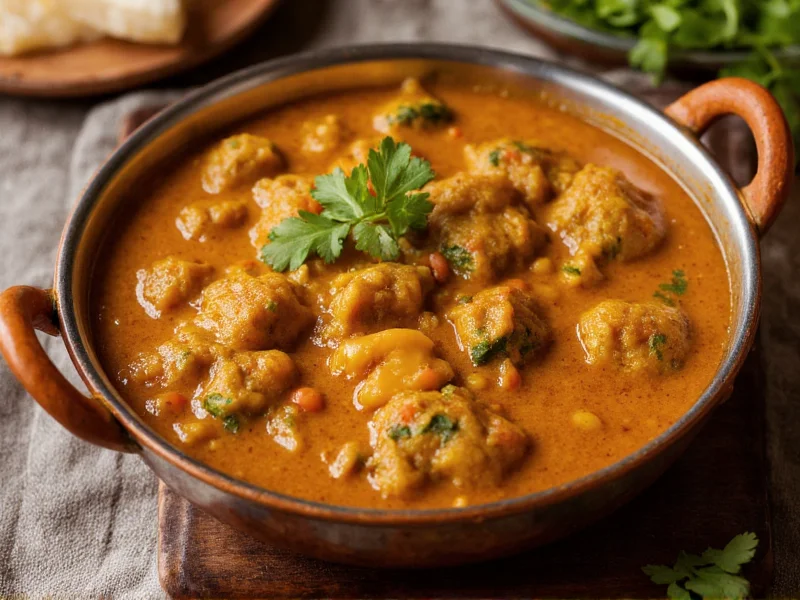Understanding what makes curry hot requires exploring the biochemistry behind spice perception. While many believe curry powder itself creates heat, the spiciness actually comes from specific ingredients added to the dish. The primary heat-inducing compound across most curry varieties is capsaicin, concentrated in the placenta (white membranes) of chili peppers. Different curry traditions use distinct chili varieties, each contributing unique heat profiles and flavor notes.
The Biochemistry of Curry Heat
When you eat spicy curry, capsaicin molecules bind to transient receptor potential vanilloid 1 (TRPV1) receptors located throughout your oral cavity and digestive tract. These receptors normally detect actual heat (above 43°C/109°F), but capsaicin tricks them into sending 'heat' signals to your brain. This explains why drinking water does little to relieve curry heat—you're experiencing a neurological response, not actual thermal heat.
The intensity of this sensation depends on several factors:
- Capsaicin concentration in the specific chili variety used
- Amount of chili membranes included in cooking (where capsaicin concentrates)
- Individual tolerance levels influenced by genetics and exposure history
- Fat content of the curry (capsaicin is fat-soluble, not water-soluble)
Regional Variations in Curry Heat Sources
Curry traditions worldwide employ different heat sources, creating distinct spicy profiles:
| Curry Type | Primary Heat Source | Scoville Range | Heat Characteristics |
|---|---|---|---|
| Indian | Bird's Eye, Kashmiri, Guntur Sannam | 50,000-1,000,000 SHU | Gradual building heat with complex flavor notes |
| Thai | Bird's Eye Chilies | 50,000-100,000 SHU | Immediate, sharp heat with citrus undertones |
| Japanese | Chili Flakes (Togarashi) | 15,000-30,000 SHU | Milder, smoky heat with sesame and citrus notes |
| Caribbean | Scotch Bonnet | 100,000-350,000 SHU | Fruity upfront heat with slow-building intensity |
Other Compounds Contributing to Curry Heat
While capsaicin dominates curry heat, other compounds play supporting roles:
- Piperine (in black pepper): Creates a different, sharper heat sensation by activating different receptors
- Gingerols (in fresh ginger): Produce a warming sensation that complements chili heat
- Mustard oils (in mustard seeds): Create a nasal-focused heat rather than mouth burn
- Allicin (in garlic): Contributes subtle background warmth in some curry blends
Professional chefs often layer these different heat sources to create complex spice profiles rather than relying solely on chili intensity. This technique explains why some intensely spicy curries feel more balanced and enjoyable than moderately hot but one-dimensional versions.
Factors Affecting Perceived Curry Heat
Several preparation and consumption factors influence how hot your curry feels:
- Cooking duration: Longer cooking can break down capsaicin, reducing perceived heat
- Fat content: Coconut milk or yogurt in curry binds capsaicin, creating milder sensation
- Absolute temperature: Hotter curry feels spicier as heat increases receptor sensitivity
- Individual biology: Genetic variations affect TRPV1 receptor density and sensitivity
- Previous exposure: Regular consumption builds temporary tolerance through receptor desensitization
Managing Curry Heat Levels
Understanding what makes curry hot allows precise control over spiciness:
- For milder curry: Remove chili membranes and seeds before cooking, add dairy or acidic components
- For controlled heat: Add chilies at different cooking stages—early for integrated heat, late for sharper punch
- For authentic regional profiles: Research traditional chili varieties rather than substituting with generic options
- When serving: Provide cooling accompaniments like raita or mango chutney to balance heat perception
Contrary to popular belief, sugar doesn't neutralize capsaicin—it merely masks the sensation by activating sweet receptors. Dairy products containing casein (like yogurt or milk) provide more effective relief by binding to capsaicin molecules.
Common Misconceptions About Curry Heat
Several myths persist about what makes curry hot:
- Myth: Curry powder determines heat level
Fact: Commercial curry powders are typically mild; heat comes from additional chilies - Myth: Red curries are always hotter than yellow or green
Fact: Color indicates primary ingredients, not heat level (green Thai curry often hottest) - Myth: Alcohol removes curry heat
Fact: Ethanol can actually enhance capsaicin absorption, potentially increasing burn - Myth: Spiciness indicates quality
Fact: Balance and complexity matter more than raw heat in professional curry preparation
Mastering curry heat requires understanding both the science of capsaicin and the culinary traditions behind different curry styles. By recognizing what makes curry hot at the molecular level, home cooks can create more balanced, flavorful dishes that deliver precisely the heat experience they desire—whether that's a gentle warmth or an intense burn.
Frequently Asked Questions
Does cooking curry longer make it hotter?
No, extended cooking typically reduces perceived heat. Capsaicin breaks down at high temperatures over time, and longer simmering allows heat compounds to distribute more evenly rather than concentrating. However, adding fresh chilies at the end of cooking preserves their full heat intensity.
Why does curry heat feel different from actual hot temperature?
Curry heat activates the same TRPV1 receptors that detect actual thermal heat, but through chemical stimulation rather than temperature change. This neurological trick makes your brain interpret the sensation as 'hot' even though no actual temperature increase occurs in your mouth.
Can you build tolerance to curry heat?
Yes, regular consumption of capsaicin creates temporary desensitization of TRPV1 receptors. This adaptation allows you to enjoy spicier foods over time, though the effect reverses if you stop consuming spicy foods for several weeks. Genetic factors also determine your baseline sensitivity to capsaicin.
Why do some people sweat when eating spicy curry?
The body interprets capsaicin activation of TRPV1 receptors as actual overheating, triggering a cooling response. This includes increased heart rate, facial flushing, and sweating—particularly on the forehead and upper lip. This reaction varies by individual and is more pronounced in people with higher sensitivity to capsaicin.
Does the heat in curry have any health benefits?
Moderate consumption of capsaicin offers several potential benefits including temporary metabolism boost, pain relief through endorphin release, and anti-inflammatory effects. However, excessive consumption can irritate the digestive tract. The key is moderation and respecting your personal tolerance limits when enjoying spicy curries.











 浙公网安备
33010002000092号
浙公网安备
33010002000092号 浙B2-20120091-4
浙B2-20120091-4